Review of nanotechnological inventions. Рубрика в журнале - Nanotechnologies in Construction: A Scientific Internet-Journal
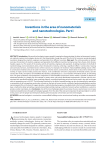
Inventions in the area of nanomaterials and nanotechnologies. Part I
Статья научная
Introduction. Advanced technologies impress people’s imagination demonstrating the latest achievements (materials, methods, systems, technologies, devices etc.) that dramatically change the world. This, first of all, concerns nanotechnological inventions designed by scientists, engineers and specialists from different countries. Main part. The article provides an abstract overview of inventions of scientists, engineers and specialists from different countries: Germany, Iraq, China, Russia, USA, Ukraine, Sweden, Japan et al. The results of the creative activity of scientists, engineers and specialists, including inventions in the field of nanotechnology and nanomaterials allow, when introduced to industry, achieving a significant effect in construction, housing and communal services, and related sectors of the economy. For example, the invention «Nanomodified building mortar» refers to construction materials and can be used in masonry of ceramic stones, ceramic bricks, hollow bricks in dry and hot climate. The novelty, in respect to the existing construction mortars, is the combination of known components of Portland cement, sand for construction works, amorphous nanomodified silica dioxide, superplasticizer С-3, cure retarders of Portland cement, air-entraining resin. The given qualitative and quantitative composition of nanomodified construction mortar makes it possible to obtain the mentioned mixtures in a simple way: for example, in gravity mixer, with evenly distributed components in volume, which is characterized with specified flowability, water-retaining property, controlled hardening period and can be used in dry and hot climate with air temperature up to 40-50°С. The following inventions in the field of nanotechnology can also be interesting for specialists: a composition of self-compacting construction concrete on the basis of cement matrix, a method of producing polarization-sensitive nanocomposite film on the basis of copper selenide, a method of producing porous moulded article in the form of insulation plaster layer, a method to obtain amorphous nanostructured diamond-like coating, a method of cement surface modification, a system to produce carbon nanotubes, et al. Conclusion. One of the most challenging tasks the economy of every country faces is to increase industrial competitiveness through technological upgrade. From the side of the state and companies the principal object to control in this process are the people and enterprises dealing with introduction of inventions and new technologies.
Бесплатно
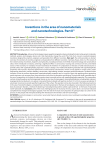
Inventions in the area of nanomaterials and nanotechnologies. Part II
Статья научная
Introduction. Advanced technologies impress people’s imagination demonstrating the latest achievements (materials, methods, systems, technologies, devices etc.) that dramatically change the world. This, first of all, concerns nanotechnological inventions designed by scientists, engineers and specialists from different countries. Main part. The article provides an abstract overview of inventions of scientists, engineers and specialists from different countries: Germany, Russia, USA, et al. The results of the creative activity of scientists, engineers and specialists, including inventions in the field of nanotechnology and nanomaterials allow, when introduced to industry, achieving a significant effect in construction, housing and communal services, and related sectors of the economy. For example, the task resolved by the invention «A composition on the basis of oxide nanostructures to provide surface with superhydrophobic properties», means to design a new method of obtaining materials with superhydrophobic properties which possess improved performance and functional characteristics which can be applied in various areas: power engineering, electronics, machine-building, construction, ship-building, aviation, aerospace and food industries. The feature of the invention is that the surfaces demonstrate superhydrophobic properties and, as a result of that, their applying allows protecting metal structures, such as power lines, frame structures, roofs, from ice formation and dirtying. The technical result is possible due to the use of composition on the basis of oxide nanostructures to provide surface with superhydrophobic properties. The composition contains tetraethoxysilane and tetraisopropyl titanate as structure-forming agents, hexamethyldisilazane as hydrophobic element, isopropyl alcohol as dissolvent, non-spheric nanocrystal titanium dioxide with particle size from 10 to 50 nm as a grow accelerator of anisotropic structures to provide specified roughness of the surface. The specialist can be also interested in the following inventions in the area of nanotechnologies: a composite heat-conducting material on the basis of nanoliquid, a nanocomposite material on the basis of potassium titanate, a method of obtaining of nanodispersed powders, hybrid supercondenser on the basis of nanosized nickel hydroxide, etc. Conclusion. One of the most challenging tasks the economy of every country faces is to increase industrial competitiveness through technological upgrade. From the side of the state and companies the principal object to control in this process are the people and enterprises dealing with introduction of inventions and new technologies.
Бесплатно
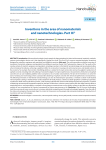
Inventions in the area of nanomaterials and nanotechnologies. Part III
Статья научная
Introduction. Advanced technologies inspire people by demonstrating the latest achievements (materials, methods, systems, technologies, devices etc.) that dramatically change the world. This, first of all, concerns nanotechnological inventions designed by scientists, engineers and specialists from different countries. Main part. The article provides an abstract overview of inventions of scientists, engineers and specialists from different countries: Russia, USA, Turkmenistan, Japan et al. The results of the creative activity of scientists, engineers and specialists, including inventions in the field of nanotechnology and nanomaterials allow, when introduced to industry, achieving a significant effect in construction, housing and communal services, and related sectors of the economy. For example, the invention «Modifying additive» is related to the road construction and can be applied in production of asphalt-concrete, including that with utilizing of nanotechnologies. To improve performance characteristics of bitumen and asphalt concrete one can use modifying additive which comprises a mix of carbon nanomaterials. The aim of the invention is to solve the task of creating new technology which could provide obtaining of asphalt concrete with enhanced performance characteristics. The following inventions in the field of nanotechnology can also be interesting for specialists: a method to obtain multi-layered nanocomposite coating; a method of laser surface treatment for steel products; a device to obtain graphene-containing suspension; a method to obtain nanocrystal silicon powder; a self-cleaning material with chemical and biological protection properties; a method of obtaining nanostructured composite material on the basis of aluminum; a device control system with the shape memory effect to manipulate micro- and nanoobjects; a method to form plasmon nanostructures on the object surfaces to provide non-destructive analysis of low concentrations of chemical compounds by Raman spectroscopy et al. Conclusion. One of the most challenging tasks the economy of every country face is to increase industrial competitiveness through technological upgrade. From the side of the state and companies the principal object to control in this process are the people and enterprises dealing with introduction of inventions and new technologies.
Бесплатно
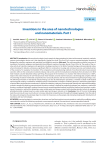
Inventions in the area of nanotechnologies and nanomaterials. Part I
Статья научная
Introduction. Advanced technologies inspire people by demonstrating the latest achievements (materials, methods, systems, technologies, devices etc.) that dramatically change the world. This, first of all, concerns nanotechnological inventions designed by scientists, engineers and specialists from different countries. Main part. The article provides an abstract overview of inventions of scientists, engineers and specialists from different countries: Germany, Russia, China, USA et al. The results of the creative activity of scientists, engineers and specialists, including inventions in the field of nanotechnology and nanomaterials allow, when introduced to industry, achieving a significant effect in construction, housing and communal services, and related sectors of the economy. For example, the invention «The composition and manufacturing method of non-fired zirconium heat-resistant concrete» refers to the construction materials industry and can be used in the manufacture of products from zirconium non-fired heat-resistant concrete obtained without pre-firing. The purpose of the invention is to increase the thermal resistance at 1300оC, improve the water resistance of non-fired zirconium heat-resistant concrete and the exclusion a technologically complex method of converting the above-mentioned components into nanoscale particles and heat-shock treatment requiring high energy costs. The following inventions in the field of nanotechnology can also be interesting for specialists: a method to obtain multi-layered nanocomposite coating: a method for modifying carbon nanomaterials in nitrogen-containing plasma; a method for regeneration of aerosol filters and protective membranes; a method for obtaining a polymer nanocomposite material with reduced flammability; a robotic complex for obtaining nanostructured chromium coatings; a method for producing hydrogen from methane, a method for forming a combined hydrophilic coating; thermochromic nanoencapsulated material, production method and a product containing such material; a method for obtaining a water-soluble paint-and-lacquer material with photobactericidal activity for applying photobactericidal coatings based on water-soluble paint-and-lacquer materials еt al. Conclusion. One of the most challenging tasks the economy of every country face is to increase industrial competitiveness through technological upgrade. From the side of the state and companies the principal object to control in this process are the people and enterprises dealing with introduction of inventions and new technologies.
Бесплатно
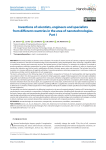
Статья научная
The article provides an abstract review of patents. The results of creative activity of scientists, engineers and specialists, including inventions in the field of nanotechnology and nanomaterials, being implemented, allow achieving a significant effect in construction, housing and community services, and related sectors of the economy. For example, the invention «A method to produce graphene-containing suspensions by means of graphite exfoliation and a device to perform it» refers to chemical and construction industries and can be used in modification of plastic lubricant, epoxy resins and concretes. The technical task of the invention is to increase efficiency of graphite exfoliation, to produce graphene-containing suspensions in continuous mode and to decrease unit labor costs for production of such suspensions. The task is achieved due to the following steps of the method: preparation of mixture of crystal graphite and liquid, graphite concentration is from 10 to 20 mass percent in container for initial suspension, supply of initial suspension into rotor plant, exfoliation of graphite and withdrawal of treated suspension from rotor plant, exfoliation of graphite is performed in several rotor plants one after another, and initial suspension is supplied into the first rotor plant by pump with fixed consumption, after treated suspension has been withdrawn from one of rotor plant, it is supplied into next rotor plant, and from the last rotor plant treated suspension is delivered into centrifugal separator, after separation centrifuge effluent is supplied into container of finish product and precipitate is delivered to a container of initial suspension in which graphite and liquid are added to obtain specified concentration of graphite in initial suspension. The specialists can also be interested in the following inventions in the area of nanotechnologies: Evolution of PV technology from conventional to nano-materials; a composition of coating for colored decoration of building walls; ferroelectric nanocomposite on the basis of porous glass and monopotassium phosphate materials; innovative technology of municipal wastewater treatment for rapid sludge sedimentation and enhancing pollutants removal with nano-material, a method to obtain powder mixture of bidispersed ceramic and metal particles, micro- and nano-plastic pollution: behavior, microbial ecology, and remediation technologies; a method to obtain multilayer wear-resistant diamond like coatings; fuel element with composite protective coating et al.
Бесплатно

Статья научная
The article provides an abstract review of patents. The results of creative activity of scientists, engineers and specialists, including inventions in the field of nanotechnology and nanomaterials, being implemented, allow achieving a significant effect in construction, housing and community services, and related sectors of the economy. For example, the invention «Method for liquidphase synthesis of nanostructured ceramic material in the CeO2–Sm2O3 system to create a solid oxide fuel cell» can contribute to the active development of alternative, hydrogen energy. Fuel cells have a wide range of applications – from batteries in portable electronic devices to large-scale power generation and autonomous use (for example, in remote areas). Power plants based on fuel cells are almost twice as economical as traditional ones. Their efficiency can reach 85%, and the amount of harmful emissions is almost 100 times lower due to the lack of direct chemical contact of the fuel with the oxidizer. The specialists can also be interested in the following inventions in the area of nanotechnologies: method of increasing the tensile strength of fiber composites by means of preliminary modification of carbon fibers with carbon nanotubes and molecules containing amino groups; preparation method of pure silver nanowires; towards safe and sustainable innovation in nanotechnology; method of distribution of carbon-based nanoparticles in the production of nanocomposite unidirectional thermoplastic tapes; device for reducing the impact of vibration and shock effects on the performance of technological equipment; high-density three-dimensional electrically conductive micro- and mesoporous material based on carbon nanotubes and / or low-layer graphenes and a method for its preparation; nanotechnology as a viable alternative for the removal of antimicrobial resistance determinants from discharged municipal effluents and associated watersheds; and others.
Бесплатно

Статья научная
Introduction. Advanced technologies impress people’s imagination demonstrating the latest achievements (materials, methods, systems, technologies, devices etc.) that dramatically change the world. This, first of all, concerns nanotechnological inventions designed by scientists, engineers and specialists from different countries. Main part. The article provides an abstract review of patents. The results of creative activity of scientists, engineers and specialists, including inventions in the field of nanotechnology and nanomaterials, being implemented, allow achieving a significant effect in construction, housing and community services, and related sectors of the economy. For example, the invention «Composite material with oriented carbon nanotubes» refers to the area of composite materials which consist of polymer matrix and filler that is often presented by carbon nanotubes. The technical result is increased tensile strength of composite material due to formation of structure of oriented carbon nanotubes in polymer matrix. That is performed by means of flat-rate flow of direct current which destroys filler agglomerates. The specialists can also be interested in the following inventions in the area of nanotechnologies: a method to produce powder containing nanocrystalline cubic tungsten carbide; a method to produce porous graphene membranes and the membranes produced with this method; suppressor coating on the basis of polymer matrix with inclusion of carbon nanotubes and a method to produce it; a method to determine location of polyethylene gas pipeline and places of possible illegal tapping of those pipeline; a method to produce biphasic thermoelectric ceramics; electron-beam system of 3D radiant nanomodification for materials and articles; lab-on-fruit skin and lab-on-leaf towards recognition of trifluralin using Ag-citrate/GQDs nanocomposite stabilized on the flexible substrate: A new platform for the electroanalysis of herbicides using direct writing of nano-inks and pen-on paper technology; and others. Conclusion. One of the most challenging tasks the economy of every country face is to increase industrial competitiveness through technological upgrade. From the side of the state and companies the principal object to control in this process are the people and enterprises dealing with introduction of inventions and new technologies.
Бесплатно

Статья научная
Introduction. Advanced technologies impress people’s imagination demonstrating the latest achievements (materials, methods, systems, technologies, devices etc.) that dramatically change the world. This, first of all, concerns nanotechnological inventions designed by scientists, engineers and specialists from different countries. Main part. The paper briefly reviews inventions made by scientists, engineers and specialists from different countries: Russia, USA, China, Belarus, Great Britain, Vietnam, Denmark, the Kyrgyz Republic. The application of the results of scientists’, engineers’ and specialists’ investigations, including inventions in the area of nanotechnology and nanomaterials allow achieving significant efficiency in construction, house and communal service, related sectors of economy. For example, the invention “A method to modify concrete with complex additive which includes hydrothermal nanoparticles SiO2 and multi-layer carbon nanotubes” refers to methods of modifying concrete by introducing combination of nanoparticles with high specific surface into concrete mixture and can be used in production of precast and monolithic parts and structures of buildings and facilities of different purpose. This method of nanomodifying concrete makes it possible to achieve increased mechanical characteristics of concrete: compressive strength (25–77% at the age of 28 days) and bending strength, resistance to damage, Young’s mod of elasticity and shearing modulus, density (up to 10%), accelerated hardening at the early age and rate of strength development, decreased water absorbtion ability and improved indicators of porous structure (pore size and pore differential size uniformity), decreased total capillary porosity, increased frost resistance. The specialists can also be interested in the following nanotechnological inventions: a method to obtain polycrystalline diamond films; phase change materials for building construction: an overview of nano-/microencapsulation, solar collector of transpiration type; a method to obtain composition for antimicrobic coating on the basis of silver sulphide associates with molecules of methylene blue; broadband electromagnetic absorbing coating; a method to produce dry building mixtures; self-organizing nanostructures and separation membrane including aquaporin water channels and the methods to produce and use them; a method to obtain nanocrystalline titanium dioxide with anatase structure, etc. Conclusion. One of the most challenging tasks the economy of every country face is to increase industrial competitiveness through technological upgrade. From the side of the state and companies the principal object to control in this process are the people and enterprises dealing with introduction of inventions and new technologies.
Бесплатно

Статья научная
Introduction. Advanced technologies impress people’s imagination demonstrating the latest achievements (materials, methods, systems, technologies, devices etc.) that dramatically change the world. This, first of all, concerns nanotechnological inventions designed by scientists, engineers and specialists from different countries. Main part. The article provides an abstract overview of inventions of scientists, engineers and specialists from different countries: Russia, USA, China, Belarus, Italy. The results of the creative activity of scientists, engineers and specialists, including inventions in the field of nanotechnology and nanomaterials allow, when introduced to industry, achieving a significant effect in construction, housing and communal services, and related sectors of the economy. For example, the invention «Protective coating and method of its application» relates to the field of protecting metals from corrosion. To obtain a protective coating, a composition containing an industrial oil with a powder of a phosphorusmodified copper-carbon nanocomposite is applied to the surface of an unalloyed steel and subjected to thermochemical activation by heating for 20 minutes at a temperature of 100–200°C. During the formation of the coating, strong donor-acceptor bonds of iron atoms with phosphorus, which are in the composition of the copper-carbon nanocomposite, are formed. In the course of experiments, it was found that heating samples with a coating of oil with the addition of a phosphorus-modified copper-carbon nanocomposite to 100–200°C increases the chemical activity of the nanocomposite, as a result of which a protective coating forms on the surface, which reduces the corrosion rate depending on the concentration of the modified metal-carbon nanocomposite. by 70–95%. The following inventions in the field of nanotechnology are also of interest to specialists: a method for obtaining a nanostructured surface of a metal workpiece by laser treatment, a device for producing nanodispersed metal oxides, a method for producing a nanostructured composite material based on aluminum, a method for modifying the surfaces of plates of a brazed plate heat exchanger, etc. Conclusion. One of the most challenging tasks the economy of every country face is to increase industrial competitiveness through technological upgrade. From the side of the state and companies the principal object to control in this process are the people and enterprises dealing with introduction of inventions and new technologies.
Бесплатно

Статья научная
Introduction. Advanced technologies impress people’s imagination demonstrating the latest achievements (materials, methods, systems, technologies, devices etc.) that dramatically change the world. This, first of all, concerns nanotechnological inventions designed by scientists, engineers and specialists from different countries. Main part. The article provides an abstract overview of inventions of scientists, engineers and specialists from different countries: Russia, USA, China, Kazakhstan, Sweden. The results of the creative activity of scientists, engineers and specialists, including inventions in the field of nanotechnology and nanomaterials allow, when introduced to industry, achieving a significant effect in construction, housing and communal services, and related sectors of the economy. For example, the invention «A method to obtain polymer-composite material and a composite reinforcement» relates to construction materials and is designed to reinforce building structures, that allows obtaining strengthened stressed composite reinforcement with improved physical-mechanical characteristics, increased resistance to aggressive environments. A method to obtain polymer-composite material is a multi-stage production of colloid solution on the basis of epoxy resin with addition of carbon nanotubes and applying heat and ultrasound impact. Introduction of modifiers (fillers) in polymer matrix in a certain ratio and fillers orientation make it possible to create a polymer strengthened for mechanical loads and with increased resistance to aggressive media (acid-resistance and alkali-resistance). The following inventions in the field of nanotechnology can also be interesting for specialists: a method to obtain biocide suspension applied on wallpaper and wall finishings, a method of aerosol spraying of nanoparticles in constant electric field, a method to obtain amorphous nanostructured diamond-like coating, a polymer composite heat-conducting paste with nanofiber modifier, a plant to provide controlled electroimpulse obtaining of nanoparticles of current conducting materials, etc. Conclusion. One of the most challenging tasks the economy of every country faces is to increase industrial competitiveness through technological upgrade. From the side of the state and companies the principal object to control in this process are the people and enterprises dealing with introduction of inventions and new technologies
Бесплатно
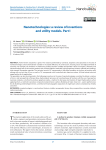
Nanotechnologies: a review of inventions and utility models. Part I
Статья научная
A brief review of patents is given. The research performed by scientists, engineers and specialists in the area of nanotechnologies and nanomaterials resulted in increased efficiency of construction, housing sector and adjacent fields of economy. For example, the invention «А method to produce titanium carbide nanopowder» refers to inorganic chemistry and nanotechnology and can be used to produce wear-resistant abrasive materials, high-temperature ceramic materials and coatings, high-strength composite materials. The technical result is TiC nanopowder in free-filled condition in the form of particles with average size no less than 30 nm, as well as TiC nanopowder with controlled ratio titanium-carbon. All that boosts technical opportunities for its application. The specialists can also be interested in the following inventions in the area of nanotechnologies: a method to obtain a mixture of micro- and nanoparticles of binary alloys, hydrocatalytic processes of recycling heavy oil fractions with the use of perspective nanosize catalysts, a method to produce graphene oxide, a method to decrease electrization of liquid hydrocarbons when applying them, a method to produce composite material boron-carbon, Modeling of static mixer (oil – water) performance for oil desalting and development test, a method of chromatographic separation of single layer carbon nanotubes by chirality and other.
Бесплатно
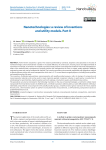
Nanotechnologies: a review of inventions and utility models. Part II
Статья научная
A brief review of patents is given. The research performed by scientists, engineers and specialists in the area of nanotechnologies and nanomaterials resulted in increased efficiency of construction, housing sector and adjacent fields of economy.For example, an invention «A method to produce metal-polymer nanocomposite materials with metal nanoparticles» refers to the method used in production of polymer articles with nanoparticles of silver or copper, widely applied in different engineering areas and used as antibacterial material. The invention provides environmental responsible and reagentless method to obtain polymer articles with metal nanoparticles which size is 5–15 nm and boosts rangeof polymers, including hemicrystalline and amorphous glass-like ones. The invention «Exfoliated polyurethane nanocomposite with polyfluoroalkyl groups» refers to design of composite and nanocomposite materials and can be used to create materials applied in polymer industry, in particularly, in production of solidcoatings for sport facilities, hydroinsulation and roof coatings, construction sealers and tribotechnical articles. The specialists can also be interested in the following inventions in the area of nanotechnologies: a method to obtain metal nanopowder from lead bronze wastes in distilled water, a method to produce collector plates, a water defluoridation method,an exfoliated polyurethane nanocomposite with polyfluoroalkyl groups, amultifunctional grease lubricant for heavy loaded friction joint, a thermostatic system to perform nanocalorimetric measurements, a self-hardening composition based on polydimethylsiloxane et al.
Бесплатно
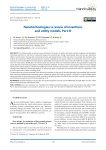
Nanotechnologies: a review of inventions and utility models. Part III
Статья научная
The article provides an abstract review of patents. The results of creative activity of scientists, engineers and specialists, including inventions in the field of nanotechnology and nanomaterials, being implemented, allow achieving a significant effect in construction, housing and community services, and related sectors of the economy. For example, the invention «Raw mixture for production of fine-grained polymer concrete modified by microsilica» refers to construction and can be used in manufacture of nanomodified concretes based on potentially chemically reactive coarse and/or fine filler for transport, industrial and civil construction. Modification of cement stone structures by means of microsilica made of silica production wastes and acrylic dispersion will make it possible to intensify hydration of binder, to reduce cement consumption and to increase strength characteristics of final product compared to traditional concrete mixtures. The invention can be used to produce concrete articles and structures, flagstones, decorative borders, to arrange top layers of road beds and to repair them when it is required, as well as to fill cracks and as a filler in sealing joints. The specialists can also be interested in the following inventions in the area of nanotechnologies: nanomodified high-strength light concrete, combined heat-insulating system, composite layered self-healing material, a method to produce metal/carbon nanocomposites, an electrochemical method to produce nanosized powder of metal silicide, a method to produce metal-polymer nanocomposite materials with metal nanoparticles et al.
Бесплатно
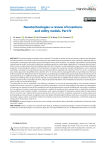
Nanotechnologies: a review of inventions and utility models. Part IV
Статья научная
The article provides an abstract review of patents. The results of creative activity of scientists, engineers and specialists, including inventions in the field of nanotechnology and nanomaterials, being implemented, allow achieving a significant effect in construction, housing and community services, and related sectors of the economy. For example, the invention “Heat-insulating material based on air gel” can be used to obtain heat-insulating materials for a wide range of applications. The required technical result, which consists in improving the thermal insulation properties of the material in a wide temperature range, increasing the absorbing properties of electromagnetic radiation in the IR spectrum, increasing the mechanical strength and flexibility, as well as reducing crumbling, is achieved in an air gel-based material containing a fibrous substrate with a density of 0.001–0.1 g/cm3, consisting of silica and/or glass and/or basalt fibers with a diameter of 0.1–5 microns, which is impregnated with an air gel obtained on the basis of silicon dioxide from alkoxysilane with the introduction of a gelling agent and followed by supercritical drying. The introduction of nanomaterials gives an additional reinforcing effect, which increases the mechanical strength of the final material and significantly reduces the crumbling of the air gel. The final material can be provided with an additional layer of fibrous substrate to increase its vibration resistance. This is especially true when using the proposed material for civil and industrial construction in seismically active zones, as well as in aircraft and rocketry. The specialists can also be interested in the following inventions in the area of nanotechnologies: nano-coating protection method for electrical connectors, preparation method of nanometric size metal oxide additives that reduce the temperature of sintering, raw material mixture for the manufacture of fine-grained polymer concrete (modified with microsilica), installation for the synthesis of carbon-containing nanomaterials, a method for producing silver nanoparticles, a method for producing nanocrystalline cubic tungsten carbide, a composition with carbon nanotubes for obtaining a carbon blank for high-density SiC/C/Si ceramics and a method for producing articles from SiC/C/Si ceramics, composite membrane for drying natural and technological gas mixtures based on graphene oxide intercalated with hydroxylated fullerene derivatives, compositions containing nanometric copper, carbon-ceramic fiber-reinforced composite material and a method for its production, a method for producing nanoparticles of aluminum oxide et al.
Бесплатно
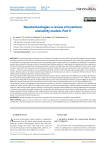
Nanotechnologies: a review of inventions and utility models. Part V
Статья научная
The article provides an abstract review of patents. The results of creative activity of scientists, engineers and specialists, including inventions in the field of nanotechnology and nanomaterials, being implemented, allow achieving a significant effect in construction, housing and community services, and related sectors of the economy. For example, the invention «A method to produce dry construction mixtures» refers to manufacturing of building materials, in particularly, to manufacture of dry construction mixtures (DCM) by the method of joint mechanoactivation of cement and dolomite, with further modification of them with carbon nanostructures (CNT). The technical result of the given method of mixing CNT and main component of dry construction mixtures - cement – is that it makes possible to use microquantities (0.005%) of CNT in DCM. That allows decreasing product cost of obtained mixture. Moreover, due to increased strength, faster hardening of materials one can reduce consumption of these mixtures. That is additional factor affecting decrease of mixture product cost. The results obtained after application of mechanoactivation of basic mixture components were different practically by all indicators from the mixtures prepared by simple mixing. Compression strength and tensile strength increased by 10–15%, adhesion strength increased too. Along with increasing of strength characteristics such an important indicator of DCM as air permeability has decreased. Reduction of total volume of pores in dense structure of cement matrix caused dramatic slow-up of moisture diffusion rate. The specialists can also be interested in the following inventions in the area of nanotechnologies: a method of laser building-up welding for metal coatings, high RAP in WMA surface mixture containing nanoglass fibers, a device to apply nanoparticles of metal oxides on metal surface under normal conditions, multifunctional nanostructured additive for coatings, experimental assessment of cement mortar using nanooxide compounds, a composition for setting constructional layers of road pavements, a method to obtain composite films of nanofibers, nano-engineering of construction materials using molecular dynamics simulations, cast and self-compacting concrete mixture for cast-in-situ concrete and prefabricated reinforced units, a method to obtain photocatalyst based on nanotubular titanium dioxide et al.
Бесплатно
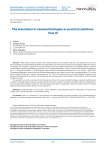
The inventions in nanotechnologies as practical solutions. Part III
Статья научная
A brief review of patents is given. The research performed by scientists, engineers and specialists in the area of nanotechnologies and nanomaterials resulted in increased efficiency of construction, housing sector and adjacent fields of economy. For example, the invention «Construction structural element» refers to the field of construction. The building element is made of a cured mixture containing the following components, wt. %: dispersed foamglass – 60–85; 25–30% alumina solution in phosphoric acid – 13–34; basalt microfiber – 2–6; fulleroid type carbon toroid-like nanoparticles (fractions from 15 to 150 nm) – 0.009–0005. The dispersed foamglass is made in the form of foamed glass beads, on the surface of which a layer of polyparaxilylene 2–5 microns thick is applied. The mixture is cured at a temperature of 160–180оC. The technical result is increased strength, toughness, crack resistance and durability at low density, that is important when building objects, for example, to create internal walls and cellular partitions in rooms. The specialists can also be interested in the following inventions in the area of nanotechnologies: composite reinforcement, a method of manufacturing composite powder material from alumina carbon nanotubes; the method of plasma deposition of nanostructured heat-shielding coating; the method of degassing tungsten nanopowder; method to produce mixtures of highly dispersed heterophase powders based on boron carbide, etc.
Бесплатно
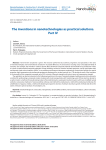
The inventions in nanotechnologies as practical solutions. Part IV
Статья научная
A brief review of patents is given. The research performed by scientists, engineers and specialists in the area of nanotechnologies and nanomaterials resulted in increased efficiency of construction, housing sector and adjacent fields of economy. For example, the invention «Carbon ceramic fiber-reinforced composite material and method for its production» refers to a class of carbon-based composite materials of heat-shielding, structural, chemical-resistant purposes, can be used under static and dynamic loads when heated to 2000оC in an oxidizing environment (aerospace engineering, construction facilities for special purposes, high-temperature electrothermal equipment, equipment for nuclear reactors, etc.). The technical result of the invention is the strength of the composite increased up to 40% in terms of flexural strength and twice in terms of compressive strength. The specialists can also be interested in the following inventions in the area of nanotechnologies: building construction elements; a method for synthesizing a composite carbon material with metal nanoparticles with transferring a part of their electron density to a carbon matrix; a method of manufacturing marker of fuel and lubricants; wastewater treatment system with nano-modified natural sorbents; nanocrystal, hydrosol of nanocrystalline cellulose and method for producing it; a method for producing membranes for ultrafiltration of aqueous media; a method of obtaining transparent ceramics of yttrium-aluminum garnet; method and device for atomic emission spectral analysis of nanoobjects, etc.
Бесплатно
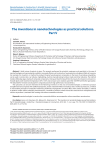
The inventions in nanotechnologies as practical solutions. Part V
Статья научная
A brief review of patents is given. The research performed by scientists, engineers and specialists in the area of nanotechnologies and nanomaterials resulted in increased efficiency of construction, housing sector and adjacent fields of economy. For example, the invention «A method to produce fireproof wood-polymer composites on the basis of secondary polyolefine» can be used in construction, car industry, shipbuilding, machine manufacturing, furniture trade and other industries. The method includes following stages: drying of composite components, mixing and heat forming of them by means of extrusion in extrusion Co- Kneader plant under treatment temperature120оС–150оС and conveyor screw rotation speed 350–450 RPM with further granulation. The obtained fire-resistant wood-polymer composite possesses high performance characteristics. The specialists can also be interested in the following inventions in the area of nanotechnologies: a method to produce strengthened nanocomposite with additional properties, anodic material for lithium-ion battery and a method to produce it, a method to rise breaking strength of composite material by preliminary impregnation of carbon fibers with carbon nanotubes, a method to produce carbon metal-containing nanostructures, a method to produce volume microscale structures from nanoparticles and a device to perform it, antistatic floor coating with carbon nanotubes and other.
Бесплатно

